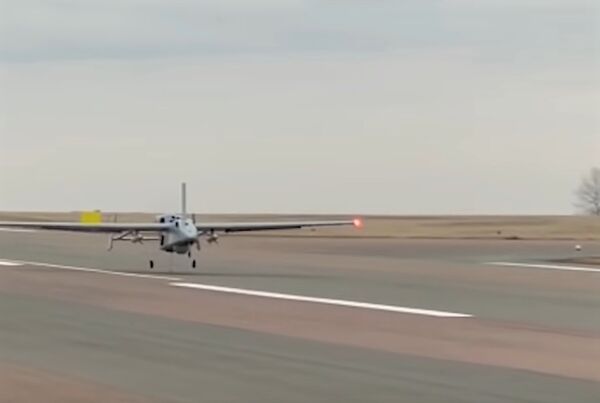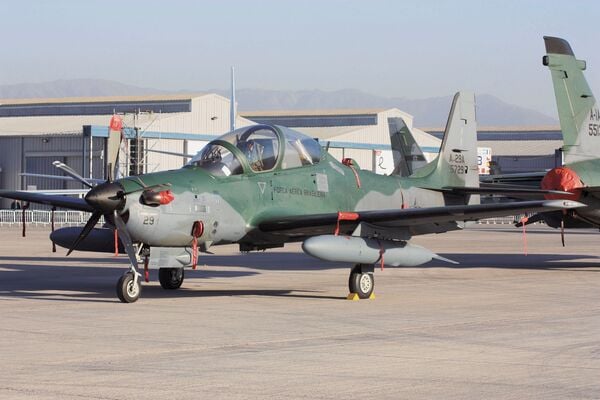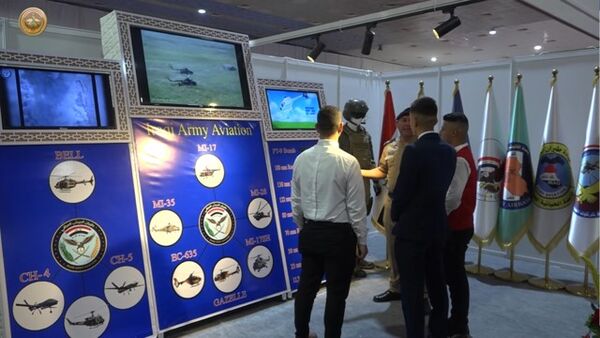- About
- Intara
- Capabilities
- Advisory
- Resources
- News
- Store
Ukraine conflict: Russia employs Forpost-R UCAV
15 March 2022
by Miko Vranic


A screenshot from a Russian MoD video showing the Forpost-R UCAV departing for a mission over Ukraine. (Ministry of Defence of the Russian Federation)
Russian forces in Ukraine have been seen fielding the Forpost-R unmanned combat aerial vehicle (UCAV) for the first time.
A video released by the Ministry of Defence (MoD) of the Russian Federation on 13 March showed an armed Forpost-R taking off from an unidentified prepared airstrip, before the footage cut to a Ukrainian multiple launch rocket system (MLRS) being destroyed by the UCAV.
The Forpost-R is an improved and indigenised model variant of the Forpost (Outpost), which is the Israeli Searcher Mk II UAV assembled by the Yekaterinburg-based Ural Civil Aviation Plant (Ural‘skiy Zavod Grazhdanskoy Aviatsii: UZGA) since 2011 under licence using components manufactured by Israel Aerospace Industries (IAI). As the relations between the West and Russia soured, in 2016 Israel bowed to US pressure and informed Russia that no further component deliveries will take place. This event spurred the MoD to embark on the Forpost indigenisation programme. Apart from indigenisation, development of an attack Forpost iteration also became an objective of the endeavour. Up to that point, Forpost was used for surveillance, reconnaissance, target acquisition and designation, artillery-fire adjustment, damage assessment, and mission overwatch.
In January 2017 the Russian Defence Minister, Sergei Shoigu, was informed by the UZGA head that an indigenised and improved model variant of Forpost would be ready for delivery in 2019. Subsequently, in August 2019, the MoD released a video of a UAV designated as the Forpost-R. The MoD also stated that the testing phase of the Forpost-R has been successfully completed and that the UAV is to enter service in 2020. In addition, the MoD revealed that the new UAV is fitted with the Russian-made APD-85 piston engine, electro-optics, electronics, datalink system, and that it runs on domestic software. The Forpost-R also features a reinforced fuselage for increased survivability. The UAV has reported maximum endurance of 18 hours and take-off weight of 500 kg, with a nearly 20,000 ft service ceiling, and a maximum range of around 400 km.
In February 2020 the MoD and UZGA signed a contract for 10 new Forpost-R UCAVs, thought to comprise three UCAVs each, for delivery by 2023.
During the Army-2021 defence exhibition held in Kubinka, Russia, in August 2021, a Forpost-R was on display, armed with two 9M133-family anti-tank guided missiles (ATGMs) of the 9K135 Kornet system. In September, during the strategic level quadrennial Zapad-2021 exercise, a Forpost-R armed with two KAB-20-family guided bombs, one under each wing, was observed in use. The Forpost-R featured in the MoD video mentioned at the beginning of the article appears to be armed with the same bomb family.
The ‘KAB' part of the designation is an acronym of Korrektiruemaya Aviatsionnaya Bomba or literally ‘corrected aerial bomb' in English, while the number ‘20' denotes the approximate weight of the ordnance in kilograms. The KAB-20-family has been developed by the Central Scientific Research Institute of Chemistry and Mechanics named after Dmitri Mendeleev in Moscow within the R&D framework named ‘Balistika-2'. The family is thought to comprise model variants with different guidance systems such as laser and satellite positioning, thought to be designated as KAB-20L and KAB-20S respectively, and with different warhead options: demolition, thermobaric, and penetration.
Apart from the 9M133 and KAB-20 family, the attack iteration of Forpost-R can also be armed with various free-fall general-purpose ‘dumb' bombs. The UAV is reportedly able to carry a maximum payload of 120 kg.
Brazil to update A-29 Super Tucano aircraft fleet
25 April 2024
by Victor Barreira


A Brazilian Air Force Embraer EMB 314 Super Tucano light attack/counter-insurgency aircraft. The details of Brazil's fleet upgrade are as yet undisclosed. (Janes/Gareth Jennings)
Embraer Defense and Security is to carry out the mid-life upgrade (MLU) of 68 of the EMB 314 (locally designated A-29) Super Tucano training and light attack aircraft of the Brazilian Air Force, the service's commander Lieutenant Brigadier Marcelo Kanitz Damasceno said on 17 April during a presentation to the Brazilian Committee on Foreign Relations and National Defense.
The MLU is intended to extend the lifespan of the aircraft by up to 25 years, Lt Brig Damasceno said, and follows a June 2023 agreement between Embraer and the Brazilian Air Force to study a technological refresh of the Super Tucanos, although details were not disclosed.
Brazil purchased 25 A-29A and 51 A-29B aircraft in 2001, adding eight A-29As and 15 A-29Bs in 2005. The fleet was received between 2003 and 2012.
For more information, please seeEmbraer sees market for 490 Super Tucanos .
India's GalaxEye developing satellite with multiple sensors for Earth observation
25 April 2024
by Oishee Majumdar


A computer-aided design model of the satellite that GalaxEye Space is developing to conduct Earth observation for defence forces. The satellite will be equipped with SAR and EO sensor for enhanced surveillance. (GalaxEye Space)
Bangalore-based GalaxEye Space is developing a satellite that can carry multiple sensors for Earth observation to support the requirements of the Indian Armed Forces.
Speaking to Janes at the Indian DefSpace Symposium 2024 held in Delhi from 18 to 20 April, Deb Jyoti Pal, senior vice-president of business development at GalaxEye said the company is planning to launch the satellite into space in early 2025 for evaluation.
This low Earth observation (LEO) satellite will host an electro-optic (EO) sensor, and a synthetic aperture radar (SAR) with both sensors capturing data simultaneously to provide a more holistic view of strategic areas of interest, Pal added.
“The SAR sensor can capture data in day and night, and in any weather condition including in foggy or cloudy environment. EO sensors are not able to do this. On the other hand, SAR data can be difficult to interpret. This is where EO data can benefit a user,” Pal said.
Iraqi Army Aviation Command identifies itself as CH-5 UAV operator
24 April 2024
by Jeremy Binnie


A still from a video released on 21 April shows the Iraqi Army Aviation Command stand at IQDEX in Baghdad. (Iraqi Ministry of Defence)
Iraqi Army Aviation Command (IAAC) has confirmed it has ordered, if not already received, Chinese-made CH-5 unmanned aerial vehicles (UAVs).
The command's stand at the International Defense Exhibition in Iraq (IQDEX) held in Baghdad from 20 to 23 April was decorated with posters that showed all the aircraft it has in service, which included the CH-5 next to the CH-4 UAV operated by its 100 Squadron.
Earlier reports that Iraq had acquired CH-5s were based on a photograph that circulated on social media in September 2023 showing a man holding a certificate in front of a projected image that identified the event as the “closing ceremony for CH-5 training” above Iraqi and Chinese flags.
A second photograph purportedly of the certificate showed it was for the successful completion of the CH-5 theoretical, practical, and flight training courses. While the graduate's name was obscured, it had stamps from the Iraqi military attaché office in China as well as the Chinese companies Poly Technologies and CH UAV Science and Technology Company.
Russian forces in Ukraine have been seen fielding the Forpost-R unmanned combat aerial vehicle (UCAV...
Latest Podcasts
Iran Israel analysis
In this podcast Janes analysts discuss the Iranian attacks on Israel on the 14 April. They highlight the military systems used by Iran and the performance and impact of these on Israel. They also discuss the implications of this attack goi...
Listen nowJanes Case Studies
Using Janes Intara to build a common intelligence picture: Russian build up on the Ukrainian border
View Case StudyNews Categories
 Defence Details
Defence Details